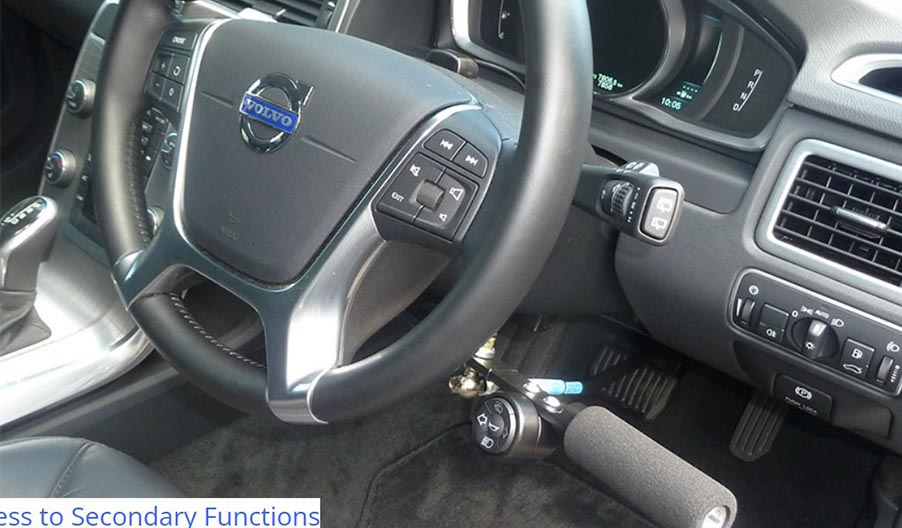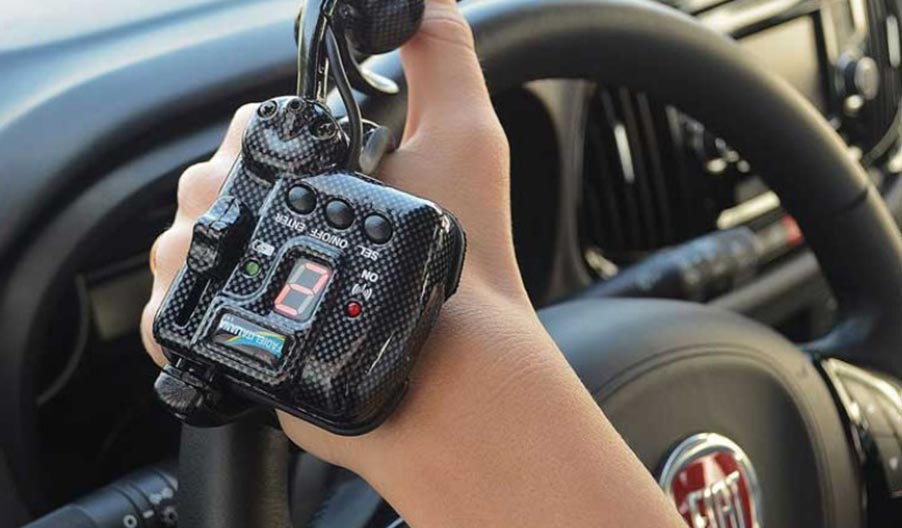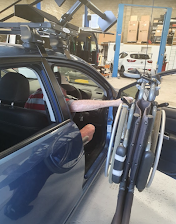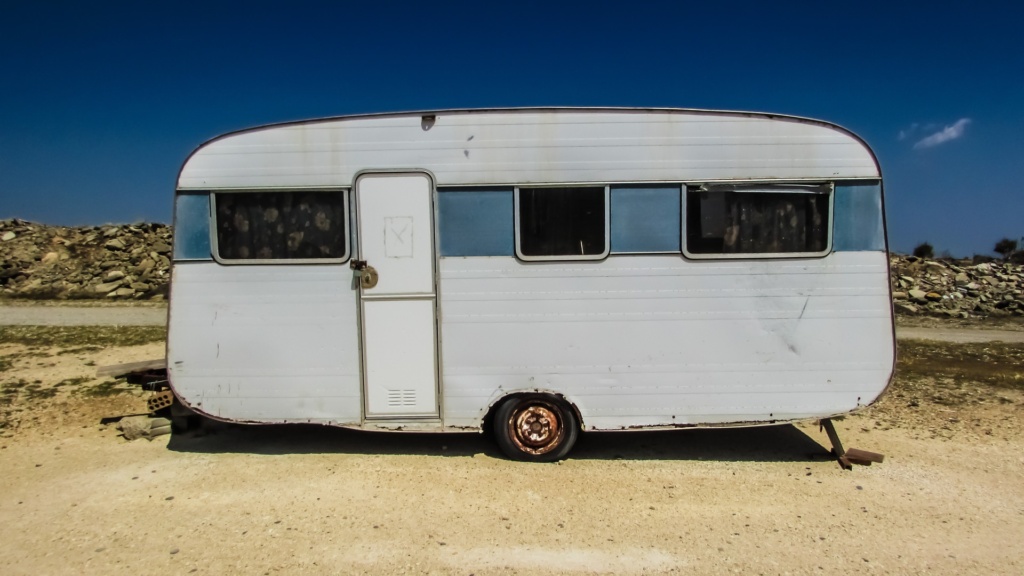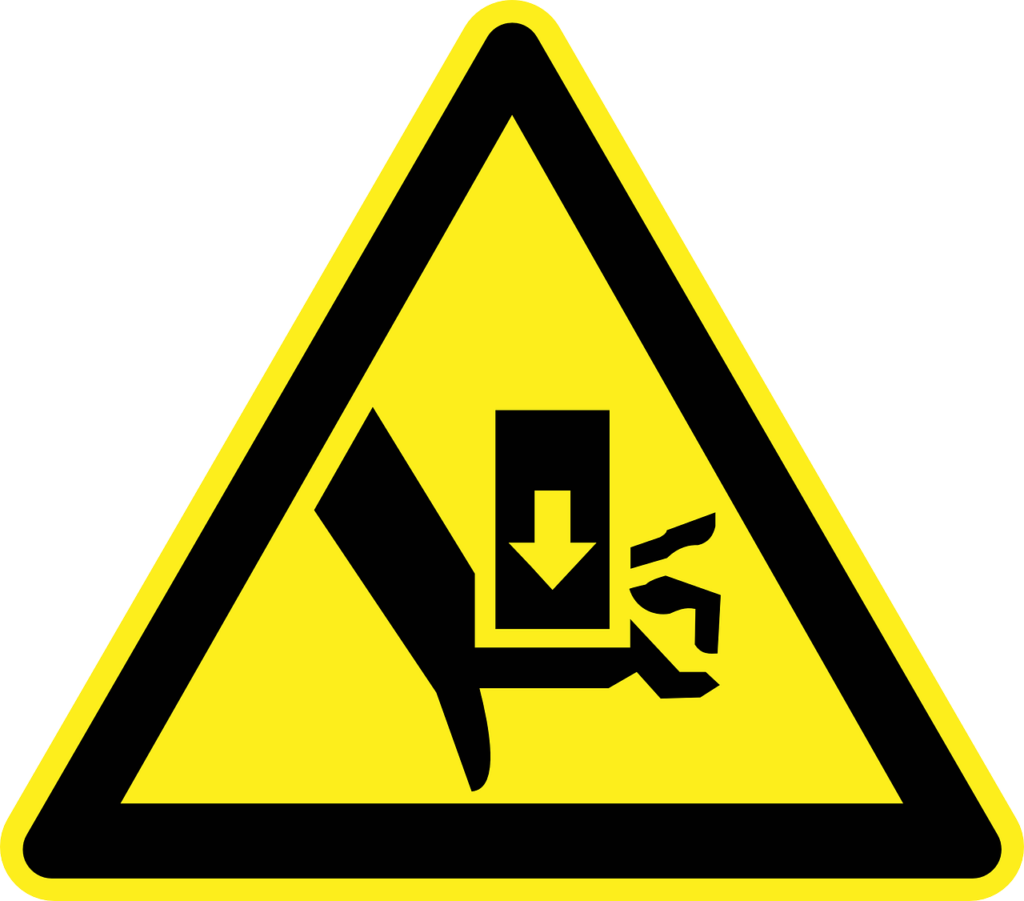In Queensland, anyone with a permanent or long-term medical condition that could impact on driving, must notify Queensland Transport and Main Roads with a Medical Certificate for Motor Vehicle Driver. Nationally, the Assessing fitness to drive for commercial and private vehicle drivers (2022) outlines the requirements of specific medical conditions and the requirements for licensing for both private and commercial vehicle licence holders.
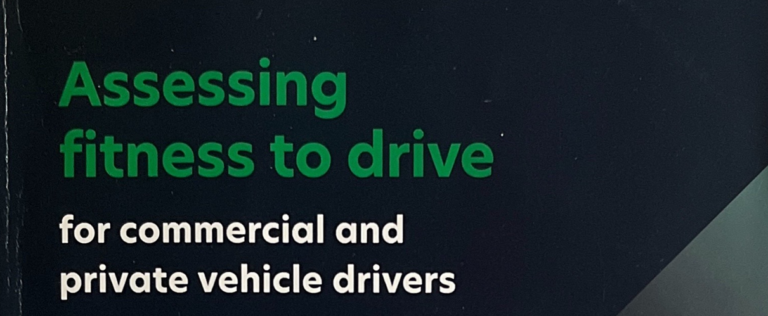
AustRoads Assessing Fitness to Drive Guidelines Definition of Driving:
Driving a motor vehicle is a complex task involved perception, appropriate judgement, adequate response time and appropriate physical capability. A range of medical conditions, disabilities and treatments may influence these driving prerequisites. Such impairment may adversely affect driving ability, possibly resulting in a crash causing injury or death.
There are many conditions that may impact on driving such as blackouts/seizures, diabetes, eye/vision problems, heart disease, neurological —dementia, stroke, or epilepsy, psychiatric disorders, sleep disorders and alcohol or drug dependency.
Anyone who has a medical condition that could impact on driving must have their treating doctor complete a Queensland Transport Medical Certificate for Motor Vehicle Driver (F3712) to continue driving. This also includes individuals over the age of 75, who must have an annual medical certificate form their treating doctor. Some conditions may require a medical specialist to complete this form. Once your doctor has completed the medical certificate form, you must submit this to Queensland Transport either in person, or scan and email the completed form to mcr@tmr.qld.gov.au. Under the conditions section on your licence, there will be an M.
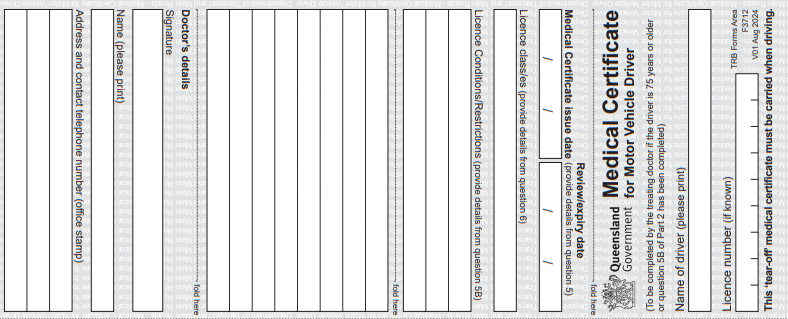
The tear of section (image above) of the form must be kept with your licence, as this outlines the requirements or conditions of your conditional licence. for some people, this is simply you must be medically reviewed by your doctor, but here may other conditions as well, depending on the nature of your condition.

Sometimes your treating doctor may be unsure whether your condition impacts on your driving and may ask for an occupational therapy driving assessment. In these situations, your doctor may ask you not to drive until you have had an assessment. In this situation, we still require you have a completed Queensland Transport Medical Certificate. We may request your doctor complete a from with the condition “the purposes of Occupational Therapy driving assessment / driving lessons in a dual controlled vehicle”. This enables the driver to be able to undertake the assessment and/or any lessons until a final determination regarding their medical fitness to drive can be made.
If you or someone you know requires an occupational therapy driving assessment, please feel free to contact Driving Well Occupational Therapy to arrange an assessment.
Useful Links:
https://www.drivingwell.com.au/
https://austroads.gov.au/publications/assessing-fitness-to-drive/ap-g56
https://www.qld.gov.au/transport/licensing/update/medical/fitness
Holiday driving can be both exciting and challenging. Whether you’re heading out for a family reunion, a beach getaway, or a scenic road trip, longer distances, heavier traffic, and unpredictable weather can add to the stress. Fatigue is one of the most common risks for drivers during holiday travel. To help you stay safe and alert on the road, here are some practical tips:

1. Get Enough Sleep Before the Trip
One of the simplest yet most effective ways to prevent fatigue is to ensure you’re well-rested before hitting the road. Aim for 7-8 hours of quality sleep the night before your journey. Starting your trip refreshed can make a significant difference in your alertness and overall driving performance.
2. Plan Frequent Breaks
Long drives can quickly become exhausting if you don’t take breaks. Before you start your journey, map out rest stops along your route. Aim to take a 15-minute break every two hours. During these stops:
Step out of the car.
Stretch your legs.
Walk around and breathe in fresh air to reinvigorate your body and mind.
3. Share Driving Duties
If you’re traveling with another licensed driver, take turns behind the wheel. Switching drivers every few hours gives each person time to rest and significantly reduces fatigue. Teamwork makes the journey smoother and safer for everyone.

4. Eat Light, Healthy Meals and Snacks
What you eat can impact your energy levels. Heavy meals often lead to sluggishness, making it harder to stay alert. Instead:
Choose light, balanced snacks like fruits, nuts, or protein bars.
Pack a variety of healthy snacks to avoid the temptation of fast food stops. Maintaining steady energy levels will help you feel more awake and focused.
5. Stay Hydrated
Dehydration can sneak up on you during long drives and contribute to tiredness. Keep a bottle of water within reach and sip regularly. While caffeine can provide a short-term boost, overindulging can lead to energy crashes and dehydration—so use it sparingly.
6. Stay Engaged and Stimulated
Monotony can make drowsiness more likely, especially on highways. Combat boredom and stay mentally stimulated by:
Listening to interesting podcasts or audiobooks.
Playing upbeat music or curated playlists. Mixing up your audio choices can help keep your mind active and focused.

7. Recognize Warning Signs of Fatigue
Fatigue can sneak up on you, so it’s crucial to recognize the early warning signs. These include:
Frequent yawning.
Drifting out of your lane.
Heavy eyelids.
Difficulty remembering the last few miles you’ve driven.
If you notice any of these signs, pull over at the nearest safe spot and rest. A short nap or even a quick walk can make a big difference in resetting your alertness.
Safe Travels and Happy Holidays!
Holiday road trips are a wonderful way to make memories, but they’re only enjoyable if you arrive safely. By following these tips, you can stay alert and ensure your journey is as pleasant as your destination. Drive safely, and have a fantastic holiday!
As driver-trained OTs, we’ve worked with many individuals who need to fine-tune their driving skills to maintain independence. While urban driving comes with its own set of challenges, rural roads are areas that often require special attention, especially for those unaccustomed to these environments.
The ARSF’s Rural Road Safety Month is a crucial campaign that brings attention to the heightened risks associated with driving on rural and remote roads in Australia.

A Closer Look at the 2023 Road Toll
In 2023, Australia saw 1,273 lives lost on its roads—a 7.9% increase from the previous year. Despite the common perception that rural areas are safer due to lower traffic volumes, almost two-thirds of these fatalities occurred on rural or remote roads.
Who is most at risk?
The data reveals that more than half of the lives lost were not drivers. Among the fatalities:
- 611 were drivers
- 251 were motorcyclists
- 210 were passengers
- 159 were pedestrians
- 35 were cyclists
- 7 were other road users
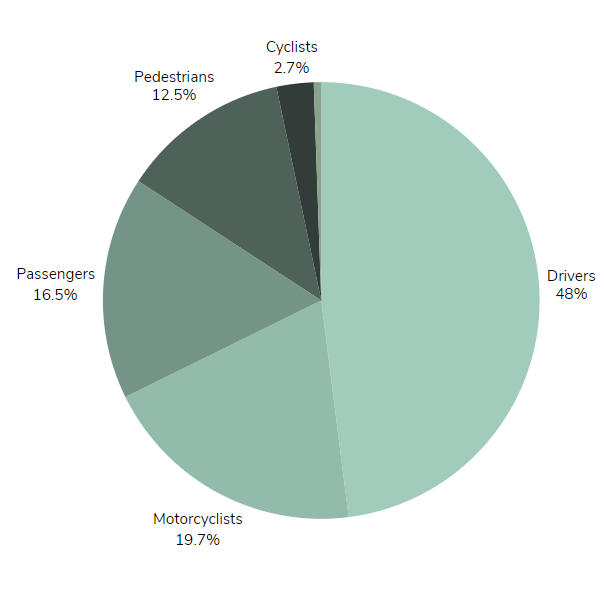
The toll was particularly high among specific demographics and during certain times:
- 3 in 4 deaths were male, highlighting a significant gender disparity in road fatalities.
- Most deaths occurred during the day (62%) and on weekdays (63%), contradicting the assumption that night-time or weekend driving is inherently more dangerous.
- By age group, those aged 40-64 years were most affected, accounting for 389 fatalities, followed by the 65+ age group with 293 fatalities, and 26-39 years with 284 fatalities.

What is the Cost?
The human cost of road fatalities is immeasurable, but the economic impact is also staggering. In 2023, the annual economic cost of road trauma in Australia was estimated at almost $30 billion.
But What Can We Do?
1. Adapt Your Speed to the Conditions
Rural roads can be deceptive. While they may seem quiet and open, they can quickly turn treacherous if you’re driving too fast. The lack of street lighting, sharp curves, and potential for loose gravel or potholes means that you need to adjust your speed to match the conditions.
2. Stay Alert for Wildlife and Farm Equipment
Wildlife is a common hazard on rural roads, especially at dawn and dusk when animals are more active. Hitting an animal can not only be tragic but also cause significant damage to your vehicle and put you in danger. Likewise, farm equipment is often slow-moving and can take up much of the road. Approach these situations with patience and care.
3. Understand the Importance of Defensive Driving
On rural roads, defensive driving is critical. This means being aware of your surroundings, anticipating potential hazards, and maintaining a safe following distance. Because rural roads are often narrower, you’ll need to be especially careful when passing other vehicles.
4. Plan Ahead for Emergencies
One of the most important aspects of rural driving is preparation. Before heading out, ensure your vehicle is in good condition—check your tire pressure, oil levels, and make sure you have a full tank of gas. Keep a roadside emergency kit in your car, and make sure your phone is fully charged. Remember, help may not be readily available in rural areas, so it’s crucial to be self-sufficient.
5. Managing Fatigue
Rural driving can be monotonous, which may lead to fatigue—a serious safety risk. To combat this, take regular breaks to stretch and rest. If you start to feel drowsy, it’s better to pull over in a safe location than to push on.
The data from 2023 paints a clear picture: rural and remote road safety remains a critical issue in Australia. With almost two-thirds of road deaths occurring in these areas, it’s more important than ever for all of us to take responsibility and make a concerted effort to reduce road trauma. By staying vigilant and adhering to road safety guidelines, we can work together to make our roads safer for everyone.
Let’s #ChooseRoadSafety and commit to making a difference—because every life lost on our roads is one too many.
People with Motor Neurone Disease go through huge changes in their daily life, incredibly quickly. All of a sudden they are unable to stand up by themselves, walk to the bathroom, go out to the shops as they previously did. All of a sudden they are unable to do the things we take for granted every day.
One man I worked with recently had this same story.
The problem…
All of a sudden he was having black outs and couldn’t walk any more. He was quickly provided with a hire wheelchair to get him by until he could get a scripted power wheelchair more suitable to his needs. When I met him in September he was still transferring into a standard car, but I knew this could change really fast. It is so important to think about the future – for MND, things can keep changing really quickly and we need to plan for the worst case scenario, and any vehicle mods solution that we recommend needs to be safe, consistent and reliable, and sustainable. It also needs to meet the insurers “reasonable and necessary” requirements.
I explained the options to to this fellow and his family, and showed a few options on vehicle modifier websites.
The lowered floor conversion to a Kia Carnival is a really effective, popular, and affordable solution, and many Australians use this option. The other options that are also equally effective include the Hyundai Staria and Volkswagen Multivan.
The trial…
The Kia Carnival looked like the way to go in this case, so I quickly commenced the process of trialling and applying to NDIS for vehicle modifications to his Kia Carnival to enable him to transport in his power wheelchair.
The trial was at the client’s home, and allowed him the opportunity to drive up into the car in his electric crashtested wheelchair, see how the restraints work, and go for a test drive. It was all smooth sailing. I gathered all the paperwork needed (there is a lot), and submitted an application to the NDIS to have the modifications funded. The client is responsible for purchasing the actual car.
The approval…
By the end of February 2024, we received approval from NDIS to proceed with vehicle modifications. This is a pretty quick turn-around time in the NDIS world. But, within this time he had lost his ability to transfer into a standard car seat. By the time the approval came through, he’d been stuck at home for 2-3 months, unable to go anywhere over the Christmas period. His hire wheelchair was not suitable for transport, and he couldn’t transfer out of it. Imagine that – being stuck in your own home over Christmas, not being able to take your kids out to celebrate the school holidays, not able to go Christmas shopping, not being able to visit family.
So, the NDIS approval came through at the end of February. Blair and his team at KM Kite on the Gold Coast bent over backwards to schedule the modifications and make it happen as quickly as possible. A job that usually takes 6-8 weeks minimum, they got sorted in less than 4 weeks. They also managed to get him a hire car NDIS had approved funding for so he could transport in the meantime. By the end of March, he had his Kia Carnival with passenger modifications for wheelchair occupant travel.

The solution!
Have a look at the smile on his face!
Lowered floor Kia Carnival delivered with a big blue bow!
He was stoked he could finally, again: be a part of taking his kids to school, going to the shops, going out to watch the footy. All the activities we take for granted every day.
His story really highlights the need for supports to be quickly accessible for people with MND, and the need for increased awareness around the challenges they face.
Zoe Wagner-Jordan, OT Driver Assessor, Driving Well Occupational Therapy
Need to get out and about?
please get in touch or have a look at our website for more information!
There is a wide range of vehicle modifications on the market which enable people with injury or disability to drive a vehicle and/or to access a vehicle.
Driver modifications:
- spinner knobs and other steering aids
- electronic steering aids eg steering knobs and satellite accelerators
- push/pull and push/pat hand controls
- over/under-ring accelerator
- indicator extension levers
- left foot accelerator
- automatic transmission conversion
Passenger / vehicle access modifications:
- wheelchair accessible conversions and fitouts
- wheelchair hoists and ramps
- lowered floors
- wheelchair tie-downs and docking stations/pins
- seating conversions
- wheelchair and scooter storage
So What do I do?
The general process with any vehicle modification is as follows:
1) Have an OT assessment and prescription from a qualified Occupational Therapist (must be a driving trained OT to prescribe driver mods). Prescription will usually require the team of client, OT, driving instructor and vehicle modifier to work together to determine the best option.
Clients returning to driving
2) Have lessons with the rehabilitation driving instructor to develop competence with the modifications
3) Have an OT on-road re-assessment if necessary
4) OT liaises with the driving instructor and informs GP/specialist that you have passed
5) Return to GP/specialist to gain new medical certificate,
6) Take updated medical certificate to QLD Transport to have licence endorsed with conditions “M” for medical condition and “V” for vehicle modification
All clients
7) Modifications must be installed and authorised by an approved officer
8) Modifications must also be reported to QLD Transport and a modification plate installed
From early on in my career as an Occupational Therapist, I had an interest in pursuing driving assessment. I don’t know what it was exactly…. I don’t particularly enjoy driving that much myself – it tires me out… I’m not really into cars – just give me my reliable Toyota! My husband and I even got by with just one car for many years, and even for about six months after our first child came along.
I like that driving provides me independence and enables me to do the things I want to do.
It enables living. And for so many people, this is true.
In our uni training, OTs learn to develop a balance between independence and safety. In my first job at Blue Care in Brisbane, it became evident to me that many older adults were teetering on the edge of becoming unsafe with their driving (if they weren’t already over the edge).
It was around this time that with my family I personally went through the experience of navigating serious concerns regarding my beloved Nanny’s driving. My family were faced with the dilemma of balancing her independence with her (and the community’s) safety. Of course safety wins in this situation, and she eventually came to the decision to give up driving, and with the support and kindness of family she found other options that enabled her to keep some independence.
Changes in my career led me to managing serious injuries at WorkCover, where I was involved in funding purchase of a new vehicle for a lovely “Grey Nomad” who had sustained spinal injuries in a scooter accident. His main vehicle was a 70 foot caravan, so he needed to be supplied with a modified van that would enable him access in a powerdrive wheelchair, and possibly allow further modifications in the future if he were to progress to return to driving. This vehicle was no less than a full fit-out of a Mercedes Sprinter costing about $70K.
Worth. Every. Penny.
Shortly after this, I was working for a private return to work provider in Brisbane. I was asked to see a courier driver who had sustained a severe right hand injury during a car accident –
don’t worry, I don’t have a picture of his actual injury… in his words with Halloween approaching at the time, his hand looked like it could have been a party entree. It would take many surgeries and months of therapy to recover, and had a poor chance of regaining full function. I just remember talking to his case manager at WorkCover and saying, let’s organise a driving assessment – he will be able to drive an automatic car with a spinner knob and though he mightn’t be able to do his usual work duties, at least he can get to his hand therapy appointments and get some normality back into his life. Not to mention, get his confidence back after his accident. Sadly, I don’t know what ended up happening for this fellow.
Before long, I found myself sitting in the Driving Assessment role at Logan (without yet having done the training), so I took myself off to Sydney for 2 weeks in September 2012 and gained the OT driving assessor qualification. I loved every minute of the course, and then managed the Logan driving service. Staff changes and life have resulted in a break from driving assessment, but my passion for this speciality didn’t fade.
Finally, knee and foot injuries sustained by some men in my family – my husband, cousin and brother-in-law – have resulted in temporary, inconvenient periods of non-driving. My husband’s injured knee was the left one, so we were able to trade in our manual car for an automatic and he was able to drive, however my cousin and brother-in-law sustained right knee and foot injuries this year. I advised them that they can have a left-foot accelerator installed and have driving lessons, but with both fellows being ineligible for funding support, they have decided to wait things out. How great to have the option though! And certainly for someone sustaining a serious permanent injury – a quick modification and some driving lessons would be such a tiny price to pay to get your independence and freedom back.
I am so excited to be doing driving assessments again, and so excited for this new adventure in private practice, and to be “keeping you safe and well on the road”.
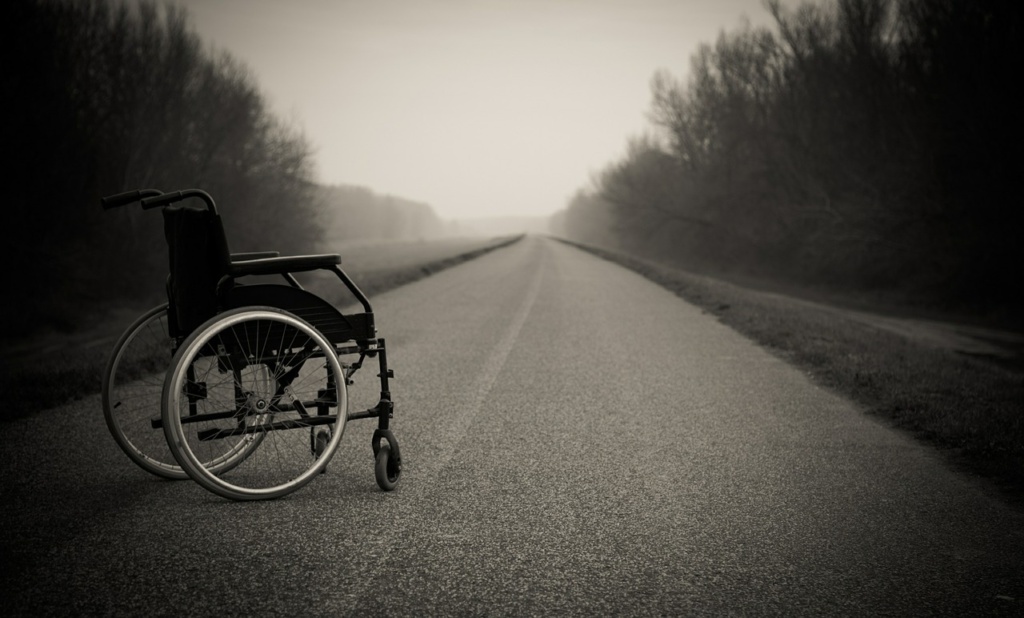
Can I help you?
Please contact me at Driving Well Occupational Therapy if you or someone you know needs an OT driving assessment.
"*" indicates required fields
- Resources
- Insights
- Forms
- Driver Focus App
Driving Well Occupational Therapy is a busy practice that provides OT driving assessment and vehicle modification services for people with medical conditions and injuries in Brisbane, Ipswich and northern Gold Coast. We service clients who are self-funding, NDIS and other compensable (WorkCover, NIISQ, TAC, iCare).
On behalf of the team at Driving Well Occupational Therapy and in the spirit of reconciliation, I acknowledge the Traditional Custodians of Turrbul and Yuggera country, where our team live and serve the majority of our clients, as well as to all Traditional Custodians of country throughout Australia and their connections to the land, sea and community. I pay my respects to Elders past and present, and extend that respect to all First Nations people today.
On behalf of the team at Driving Well Occupational Therapy and in the spirit of reconciliation, I acknowledge the Traditional Custodians of Turrbul and Yuggera country, where our team live and serve the majority of our clients, as well as to all Traditional Custodians of country throughout Australia and their connections to the land, sea and community. I pay my respects to Elders past and present, and extend that respect to all First Nations people today.

